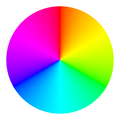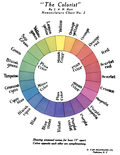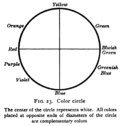Color wheel
Color Wheel in Medicine
The Color Wheel is a circular diagram of colors used to illustrate relationships between colors. Although primarily associated with art and design, the color wheel has applications in the medical field, particularly in understanding skin conditions, psychological effects of colors, and the design of healthcare environments.
History[edit]
The concept of the color wheel dates back to Sir Isaac Newton's experiments with prisms in the late 17th century. Newton's color circle was the first to arrange colors in a natural progression around a circle. This arrangement helped to understand color relationships, such as complementary colors and analogous colors. Over the centuries, various versions of the color wheel have been developed, each tailored to specific applications, including its use in medicine.
Application in Medicine[edit]
Skin Conditions[edit]
In dermatology, the color wheel is used to diagnose skin conditions based on color changes. For example, erythema (redness of the skin) can indicate conditions such as infection, allergic reactions, or autoimmune diseases. Cyanosis (bluish or purplish skin color) suggests issues with oxygenation, potentially pointing to respiratory or cardiovascular problems. Understanding the nuances of skin color changes is crucial for accurate diagnosis and treatment.
Psychological Effects[edit]
Colors have a significant impact on patients' emotions and psychological state. The use of specific colors in healthcare settings can influence mood, stress levels, and even perception of pain. For instance, blue and green are often used in hospitals and clinics for their calming effects. Knowledge of color psychology is essential in designing patient rooms, waiting areas, and therapy spaces to promote healing and well-being.
Healthcare Environment Design[edit]
The design of healthcare environments, including hospitals, clinics, and care homes, often utilizes the color wheel to create spaces that are conducive to healing. Color choices can affect patients' perception of space, light, and warmth. Careful selection of colors can make environments less intimidating and more comforting for patients, which is critical in reducing stress and promoting recovery.
Color Vision and Health[edit]
Color vision deficiencies, such as color blindness, can have implications for patient care. Healthcare professionals need to be aware of these deficiencies in both patients and staff to ensure clear communication and safety. For example, color-coded charts, medications, and equipment need to be accessible to those with color vision deficiencies.
Conclusion[edit]
The color wheel is a valuable tool in medicine, offering insights into skin conditions, the psychological impact of colors, and the design of healthcare environments. Its application extends beyond aesthetics, playing a crucial role in diagnosis, patient care, and the overall healthcare experience.
-
Color wheel
-
Color wheel
-
Color wheel
-
Color wheel
-
Color wheel
-
Color wheel
-
Color wheel
-
Color wheel
-
Color wheel
-
Color wheel
-
Color wheel
-
Color wheel
Ad. Transform your life with W8MD's Budget GLP-1 injections from $75


W8MD offers a medical weight loss program to lose weight in Philadelphia. Our physician-supervised medical weight loss provides:
- Weight loss injections in NYC (generic and brand names):
- Zepbound / Mounjaro, Wegovy / Ozempic, Saxenda
- Most insurances accepted or discounted self-pay rates. We will obtain insurance prior authorizations if needed.
- Generic GLP1 weight loss injections from $75 for the starting dose.
- Also offer prescription weight loss medications including Phentermine, Qsymia, Diethylpropion, Contrave etc.
NYC weight loss doctor appointmentsNYC weight loss doctor appointments
Start your NYC weight loss journey today at our NYC medical weight loss and Philadelphia medical weight loss clinics.
- Call 718-946-5500 to lose weight in NYC or for medical weight loss in Philadelphia 215-676-2334.
- Tags:NYC medical weight loss, Philadelphia lose weight Zepbound NYC, Budget GLP1 weight loss injections, Wegovy Philadelphia, Wegovy NYC, Philadelphia medical weight loss, Brookly weight loss and Wegovy NYC
|
WikiMD's Wellness Encyclopedia |
| Let Food Be Thy Medicine Medicine Thy Food - Hippocrates |
Medical Disclaimer: WikiMD is not a substitute for professional medical advice. The information on WikiMD is provided as an information resource only, may be incorrect, outdated or misleading, and is not to be used or relied on for any diagnostic or treatment purposes. Please consult your health care provider before making any healthcare decisions or for guidance about a specific medical condition. WikiMD expressly disclaims responsibility, and shall have no liability, for any damages, loss, injury, or liability whatsoever suffered as a result of your reliance on the information contained in this site. By visiting this site you agree to the foregoing terms and conditions, which may from time to time be changed or supplemented by WikiMD. If you do not agree to the foregoing terms and conditions, you should not enter or use this site. See full disclaimer.
Credits:Most images are courtesy of Wikimedia commons, and templates, categories Wikipedia, licensed under CC BY SA or similar.
Translate this page: - East Asian
中文,
日本,
한국어,
South Asian
हिन्दी,
தமிழ்,
తెలుగు,
Urdu,
ಕನ್ನಡ,
Southeast Asian
Indonesian,
Vietnamese,
Thai,
မြန်မာဘာသာ,
বাংলা
European
español,
Deutsch,
français,
Greek,
português do Brasil,
polski,
română,
русский,
Nederlands,
norsk,
svenska,
suomi,
Italian
Middle Eastern & African
عربى,
Turkish,
Persian,
Hebrew,
Afrikaans,
isiZulu,
Kiswahili,
Other
Bulgarian,
Hungarian,
Czech,
Swedish,
മലയാളം,
मराठी,
ਪੰਜਾਬੀ,
ગુજરાતી,
Portuguese,
Ukrainian











